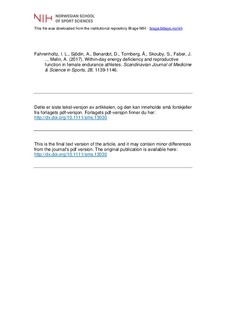Within-day energy deficiency and reproductive function in female endurance athletes
| dc.contributor.author | Fahrenholtz, Ida Lysdahl | |
| dc.contributor.author | Sjödin, Anders | |
| dc.contributor.author | Benardot, Dan | |
| dc.contributor.author | Tornberg, Åsa | |
| dc.contributor.author | Skouby, Sven | |
| dc.contributor.author | Faber, Jens | |
| dc.contributor.author | Sundgot-Borgen, Jorunn | |
| dc.contributor.author | Melin, Anna | |
| dc.date.accessioned | 2018-12-13T12:50:09Z | |
| dc.date.available | 2018-12-13T12:50:09Z | |
| dc.date.created | 2017-12-06T11:08:02Z | |
| dc.date.issued | 2017 | |
| dc.identifier.citation | Scandinavian Journal of Medicine & Science in Sports. 2018, 48, 1139-1146. | nb_NO |
| dc.identifier.issn | 0905-7188 | |
| dc.identifier.uri | http://hdl.handle.net/11250/2577612 | |
| dc.description | I Brage finner du siste tekst-versjon av artikkelen, og den kan inneholde ubetydelige forskjeller fra forlagets pdf-versjon. Forlagets pdf-versjon finner du på onlinelibrary.wiley.com / In Brage you'll find the final text version of the article, and it may contain insignificant differences from the journal's pdf version. The definitive version is available at onlinelibrary.wiley.com | nb_NO |
| dc.description.abstract | We aimed to estimate and compare within-day energy balance (WDEB) in athletes with eumenorrhea and menstrual dysfunction (MD) with similar 24-hour energy availability/energy balance (EA/EB). Furthermore, to investigate whether within-day energy deficiency is associated with resting metabolic rate (RMR), body-composition, S-cortisol, estradiol, T3, and fasting blood glucose. We reanalyzed 7-day dietary intake and energy expenditure data in 25 elite endurance athletes with eumenorrhea (n=10) and MD (n=15) from a group of 45 subjects where those with disordered eating behaviors (n=11), MD not related to low EA (n=5), and low dietary record validity (n=4) had been excluded. Besides gynecological examination and disordered eating-evaluation, the protocol included RMR-measurement; assessment of body-composition by dual-energy X-ray absorptiometry, blood plasma analysis, and calculation of WDEB in 1-hour intervals. Subjects with MD spent more hours in a catabolic state compared to eumenorrheic athletes; WDEB <0 kcal: 23.0 hour (20.8–23.4) vs 21.1 hour (4.7–22.3), P=0.048; WDEB <-300 kcal: 21.8 hour (17.8–22.4) vs 17.6 hour (3.9–20.9), P=0.043, although similar 24-hour EA: 35.6 (11.6) vs 41.3 (12.7) kcal/kg FFM/day, (P=0.269), and EB: -659 (551) vs -313 (596) kcal/day, (P=0.160). Hours with WDEB <0 kcal and <-300 kcal were inversely associated with RMRratio (r=-0.487, P=0.013, r=-0.472, P=0.018), and estradiol (r=-0.433, P=0.034, r=-0.516, P=0.009), and positively associated with cortisol (r=0.442, P=0.027, r=0.463, P=0.019). In conclusion, although similar 24-hour EA/EB, the reanalysis revealed that MD athletes spent more time in a catabolic state compared to eumenorrheic athletes. Within-day energy deficiency was associated with clinical markers of metabolic disturbances. | nb_NO |
| dc.language.iso | eng | nb_NO |
| dc.subject | amenorrhea | nb_NO |
| dc.subject | catabolism | nb_NO |
| dc.subject | energy availability | nb_NO |
| dc.subject | relative energy deficiency | nb_NO |
| dc.subject | resting metabolic rate | nb_NO |
| dc.subject | within-day energy balance | nb_NO |
| dc.title | Within-day energy deficiency and reproductive function in female endurance athletes | nb_NO |
| dc.title.alternative | Within-day energy deficiency and reproductive function in female endurance athletes | nb_NO |
| dc.type | Journal article | nb_NO |
| dc.type | Peer reviewed | nb_NO |
| dc.description.version | acceptedVersion | nb_NO |
| dc.source.pagenumber | 24 | nb_NO |
| dc.source.journal | Scandinavian Journal of Medicine & Science in Sports | nb_NO |
| dc.identifier.doi | 10.1111/sms.13030 | |
| dc.identifier.cristin | 1523428 | |
| dc.description.localcode | Seksjon for idrettsmedisinske fag / Department of Sports Medicine | nb_NO |
| cristin.unitcode | 150,34,0,0 | |
| cristin.unitname | Seksjon for idrettsmedisinske fag | |
| cristin.ispublished | true | |
| cristin.fulltext | postprint | |
| cristin.qualitycode | 2 |
Tilhørende fil(er)
Denne innførselen finnes i følgende samling(er)
-
Artikler / Articles [2096]
